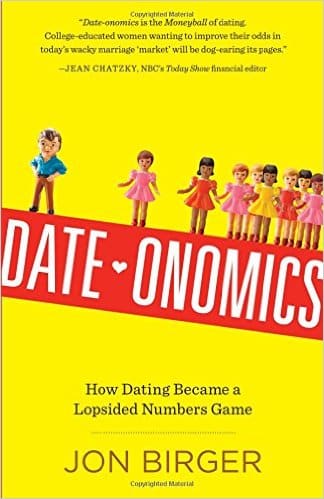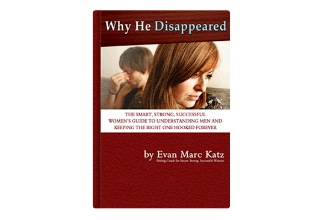Dateonomics by Jon Birger — Book Review by Evan Marc Katz

- Dating, What Men Want
Every day I read something new about dating and relationships. Usually, it’s an article or study that I share on Thursdays. But I rarely read books about dating; it’s too much like my day job. When I’m done with work, I generally prefer dysfunctional family fiction by, say, Jonathan Franzen or Elizabeth Strout.
Yet every so often, I come across a book that intrigues me enough to review. There was Hanna Rosin’s “The End of Men.” There was Laura Kipnis’s “Men”, and there was Suzanne Venker’s “How to Choose a Husband”.
Today, I want to tell you about Jon Birger’s “Dateonomics.”
It’s going to get a lot of news coverage — and it should — for it highlights some sobering facts about the perception that there are “no good men out there.”
I’ll admit, I went into the read with a very skeptical eye. A big part of my business is giving women hope. Not false hope; I’m the world’s worst liar and fake cheerleader. But I have always believed that for every good woman, there is an equivalent good man. By the time you’re done reading “Dateonomics,” you might think otherwise.
The premise of the book is simple: the gap between college-educated women and college-educated men is widening rapidly. In 1981, there was about a 50/50 split between college graduates from both genders. Look at what happened in 30 years:
“In 2012, women earned 1,025,729 bachelors vs. 765,317 for men. That’s 34% more women than men who graduated from college. It’s predicted that by 2023, women college graduates will outnumber men by 47%.
Why does that make a difference? Birger suggests that it’s nothing more than a math equation. Men are buyers. Women are sellers. And when there are too many sellers, the buyers have control and can drive the prices down. Specifically for sex.
If a guy can get a woman to come to his house for sex without a phone call, without dinner and a movie, and without exclusivity, what incentive does he have to stop?
In Birger’s words, “Lopsided gender ratios turn some nice guys into monsters.”
Basically, an average guy can get on Tinder, swipe right, and text a dozen women at once. And since there are so many more women than men, the women feel they’re “competing” for his affections. This naturally affects the way men court women.
They don’t.
They don’t have to.
If a guy can get a woman to come to his house for sex without a phone call, without dinner and a movie, and without exclusivity, what incentive does he have to stop?.
Birger puts into numbers the patterns we’ve been observing anecdotally. Women in cities like New York really do have the deck stacked against them.
“Subtract the estimated gay and lesbian population from Manhattan’s total population count, and you wind up with a hetero dating pool with 39 percent more college-educated women than men age 22 to 39. For college grads, age 22 to 29, removing the gay and lesbian population from the numbers pushes the oversupply of women relative to men up from 39 percent to 54 percent.”
Harrowing, huh? And it only gets worse as you get older.
“Today’s 40-year-old college educated woman started out in a dating pool with 117 women for every 100 men, or 17 percent more women than men…However, once two-thirds of the men in the 40-year-old’s original dating pool had gotten married, the remaining single women were confronted by a far more daunting dating market, one with 50 women for every 33 men. That’s 52% more women than men.”
Now, to be fair, this seems to assume that the dating pool is static — that people get married and are off the market forever. In fact, a decent percent of men get married AND divorced before 40. The average age of divorce is 30 and a full 60% of the men who marry between 20-25 get divorced. All of them go right back into the dating pool. Regardless, these are pretty eye-opening numbers that Birger suggests are tantamount to a game of musical chairs:
If there are three women for every two men, and two couples pair off, that leaves one woman standing alone.
Eventually, most men WANT to commit. Which is why 80% of the population still gets married.
It’s a fair point, but I don’t think it’s that simple. For even though Birger is presumably correct on the statistics, it does not mean the story is over and that women should give up. Not by a long shot.
First, there is something a bit elitist in only giving numbers on college-educated women who want college-educated men. People with Bachelors degrees only account for only 40% of the population. That leaves 60% of the population. I understand why educated people want to date educated people, but let’s not pretend that everyone who didn’t go to college is a drooling moron.
Next, I have to somewhat quibble with the musical chairs theory. Technically, if you lined up 1,025,729 women and 765,317 men (people who graduated college in 2012) and made them all pair up, sure enough, you’d have 250,000 women twiddling their thumbs. But that’s not how dating works.
Many women are focused on their careers. Many women have no interest in dating. Many women are depressed or in a bad emotional state. Many women have given up on men. Many women have no desire to be married. There are a LOT of women who have opted out of the marriage sweepstakes, in other words. Now, we don’t know if there are an equal number of men who have opted out, but I think it’s safe to say the musical chairs metaphor doesn’t quite hold water. It’s not like we’re looking at 100,000,000 chairs for 120,000,000 people. The numbers are too fluid — and also too large.
No matter where you go, no matter what your gender, there’s going to be a finite number of people who are actively dating, emotionally available, attractive, educated, commitment-oriented and interested in you. Go onto Match or OkCupid. That’s a random sampling of what’s out there and both sites’ gender ratios are close to 50/50. And if that’s the case, how much time do you want to spend worrying that, societally, there are more women college graduates than men?
My point is not to entirely negate Birger’s use of game theory, which suggests that men turn into players because they don’t have to commit. It’s just not the full story. Eventually, most men WANT to commit. Which is why 80% of the population still gets married. And why, as a single woman, you’re never going to run out of college educated men to choose from. The game of musical chairs never actually ends. Match will never go out of business, I will never go out of business, and just about everyone who wants to get married eventually gets married.
Long story short: even if there are more women on a macro level, on a micro level, I don’t think it makes that much of a difference. There are still tons of guys out there.
However, the author does make some very salient points that echo things you may have read here — particularly about how female maximizers can be left standing alone because they were consumed with their careers, didn’t prioritize love, and felt they deserved to be picky.
“With a lot at stake in getting it right in one shot, it’s the women who are confident that they are holding a strong hand who are likely to hold out and wait for the perfect prospect.”
This is why it seems that there are a disproportionate number of “quality” 40-year old single women. Like Lori Gottlieb, they were holding out for a 10, while the appropriate guys settled down with other women who may have been less impressive on paper but who prioritized love and compromise.
Birger’s solution to this is that women should pursue men. I don’t think that feels good for most women, nor do I think it’s very effective. What I do concede, is that it behooves all of us to date extensively through our 20’s, to grow and mature, and figure out what works for us, so that we can realistically settle down between 30-35 instead of 35-45. Life doesn’t always work that way, of course, but it’s hard to argue that prioritizing love is, in any way, “bad” for you.
Whether we like it or not, it is a competitive market for women and if you approach your love life seriously and proactively you’re more likely to find the love you want.
The author concludes his sobering math lesson with a few recommendations, based on the numbers alone, as opposed to any real-world practicality.
-
- 1.
Choose a college based on its sex ratio.
-
- According to Birger, one-quarter of college-educated American couples met in college or grad school. While he’s correct that there are more single college-educated men at age 26 than at age 36, the problem is that 26-year-old men, for the most part, are not really ready to get married. They haven’t lived enough, found their careers, made enough money, slept around enough, nor are they necessarily mature and selfless enough to be health partners. But yes, there are a lot more of them when they’re fresh out of college.
2. Factor gender ratio into your career decision. Since 10% of couples meet at work, you increase your odds of meeting a man if you go into a science and math career. Of course, then you’d have to marry a science and math guy.
3. Move West. There are closer to equal male to female ratios in Western states, as compared to Eastern and Southern state. California has a 12% difference for women 30-39. North Carolina has a 38% gap for the same demographic. That’s all well and good, but how many people are going to blindly go to a state with no job and no family to increase their statistical odds of finding a college-educated husband?
4. Expand dating pool to lesser-educated men. This may sound like the least desirable option, but it’s likely to be the most effective. Look at, say, the dating pool for black women: 112,989 black women vs. 59,119 black men graduated college in 2011. As a result, educated black women have little choice but to consider dating less educated black men — if they choose to date black men. As I’ve written before, there is a sizable difference between dating someone who doesn’t have an advanced degree and dating someone unintelligent. These days, 24% of marriages have a wife that earns more (up from 6% in 1960), so this model is going to be more prevalent in the future.
I know there’s a lot of information here — and I know that there’s the temptation to pull out the most sensational headline from this (“Women are screwed!”), but I would urge you to stay calm.
In a country with 50 million single men, it only stands to reason that there’ll be one who is a perfect fit for you. If you take anything from this book review, it’s that, there is competitive market for women seeking educated men and if you approach your love life seriously and proactively you’re more likely to find the love you want.
Click here to pick up a copy of Dateonomics and please share your thoughts about this piece below.









Comments